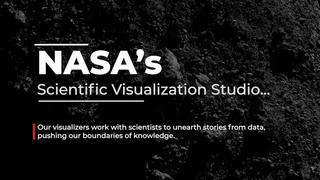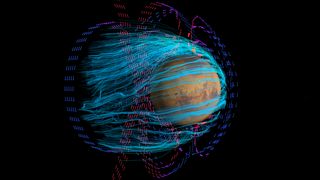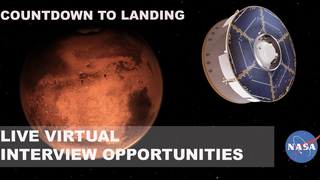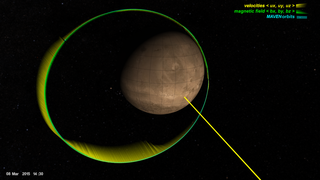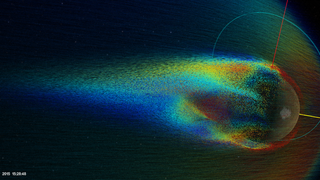Planets and Moons
ID: 4730
Unlike the Earth, Mars lacks a global magnetic dipole. Because its upper atmosphere is ionized by solar X-rays and extreme ultraviolet (EUV) radiations, the ionosphere of Mars presents a highly conductive obstacle to the flow of the magnetized solar wind plasma. The resulting interaction induces electric currents in the ionosphere which, in turn, create sufficient magnetic pressure to slow and deflect the solar wind around the bulk of the ionosphere, forming an induced magnetosphere.
NASA scientists used magnetic field measurements from the Mars Atmosphere and Volatiles EvolutioN (MAVEN) orbiter to make the first quantitative global map of the induced currents that shape the Martian induced magnetosphere. In doing so they found strong asymmetries between the north-south electric-polar hemispheres, particularly in the concentration of sunward currents, an electric connection between the planet's ionosphere and its bow shock, as well as a twist in the global near-Mars current system. Mapping the currents reveals how the solar wind's energy transfers into the induced magnetosphere where it powers escape of the Martian atmosphere.
Here we show visualizations of the actual and the idealized current systems that are formed as a result of a solar wind driven convective electric field. In addition, a sequence of calculated magnetic fields measured by MAVEN shown here illustrates that magnetic fields are forced to wrap around the planet by currents induced in Mars’ ionosphere.
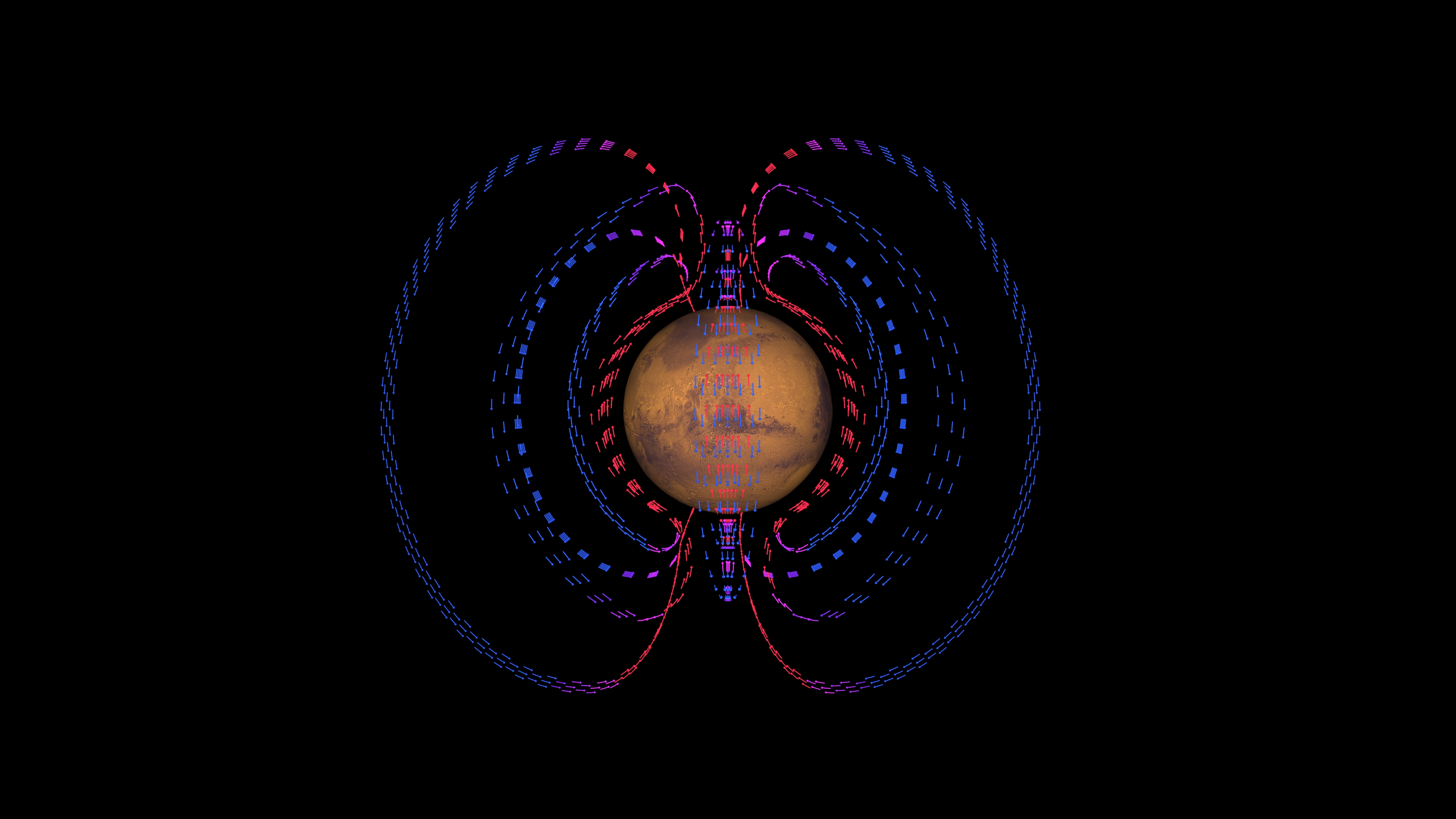

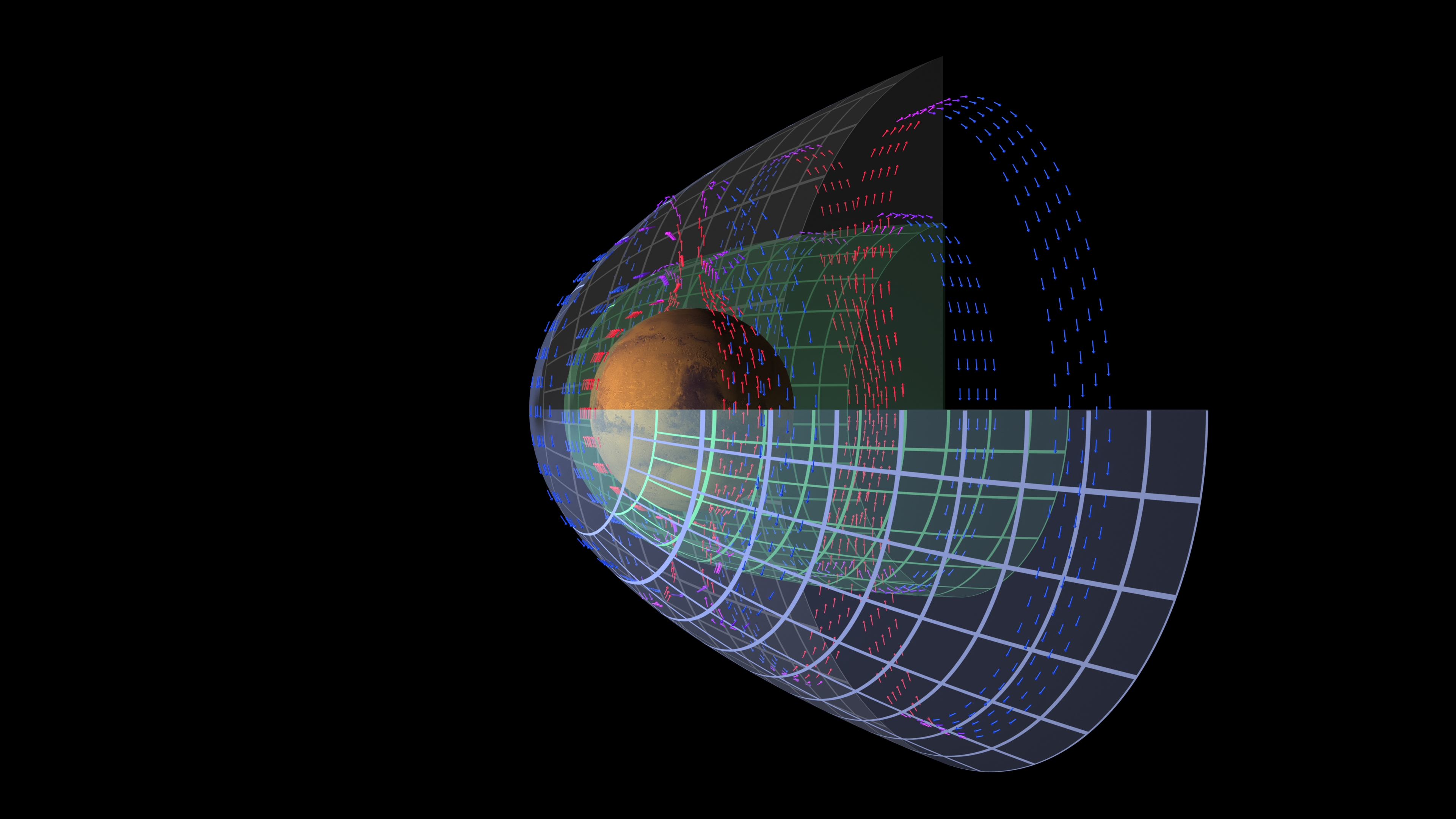
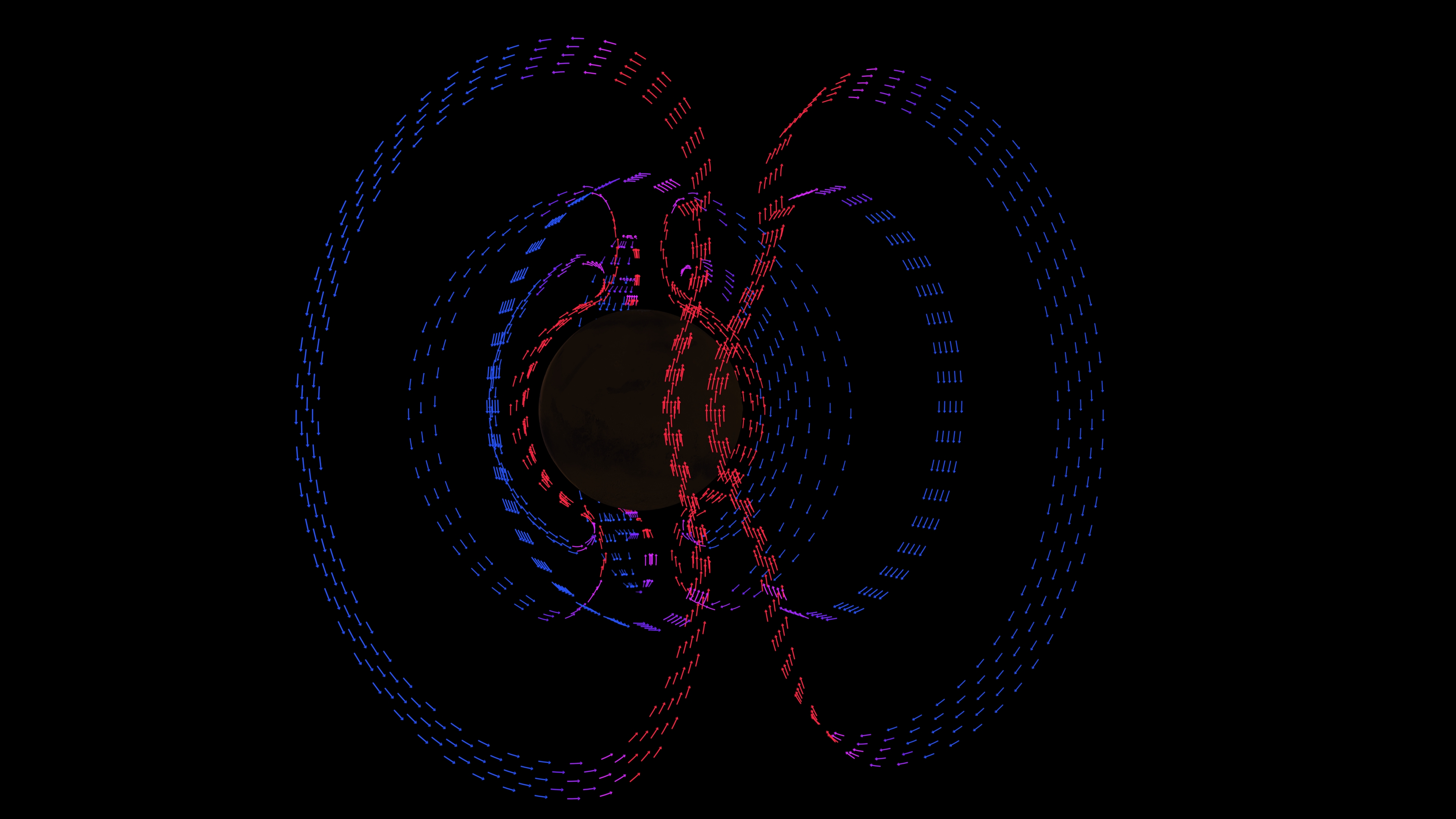
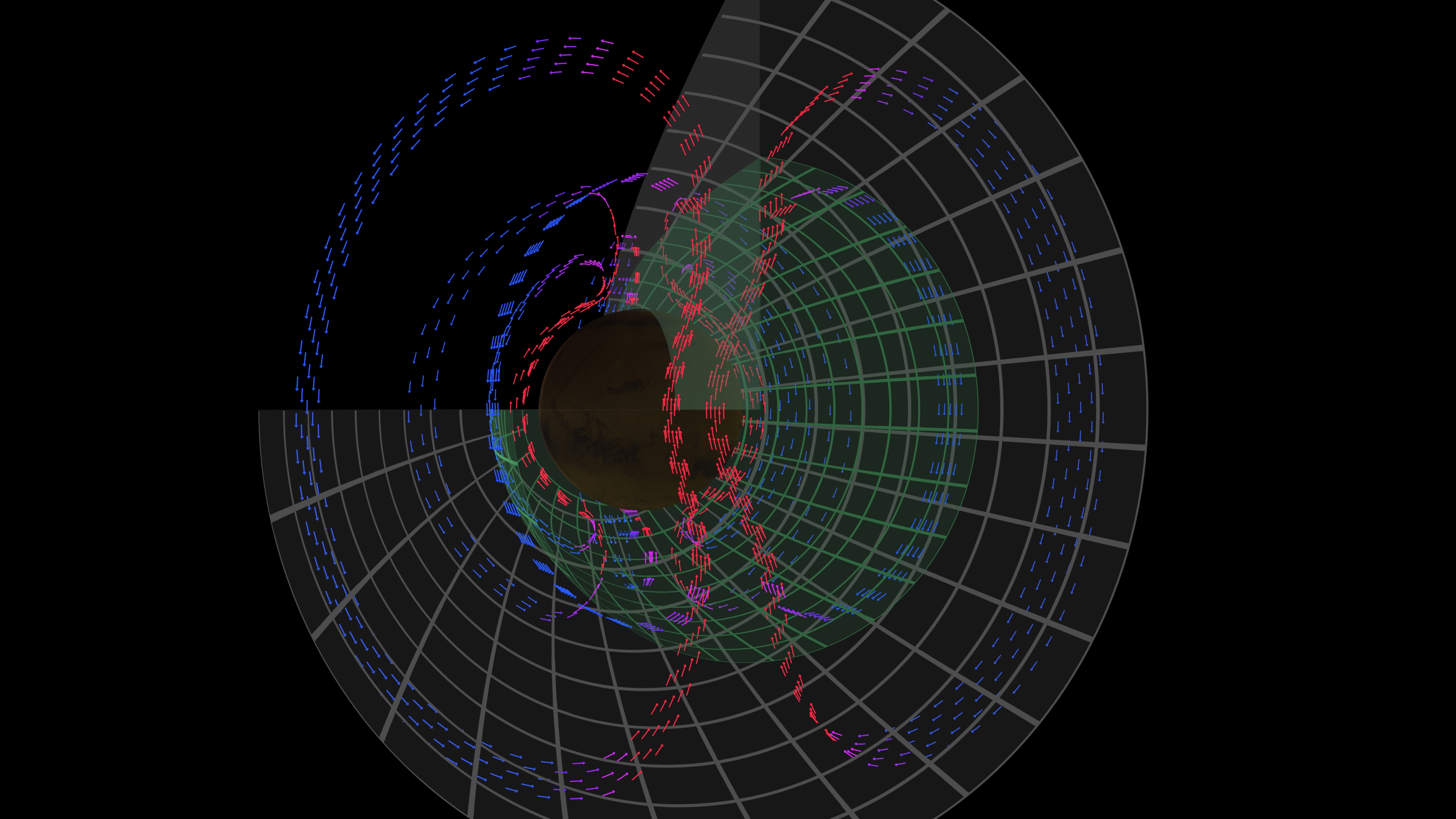
MAVEN – Mars Electric Current Systems
NASA scientists used magnetic field measurements from the Mars Atmosphere and Volatiles EvolutioN (MAVEN) orbiter to make the first quantitative global map of the induced currents that shape the Martian induced magnetosphere. In doing so they found strong asymmetries between the north-south electric-polar hemispheres, particularly in the concentration of sunward currents, an electric connection between the planet's ionosphere and its bow shock, as well as a twist in the global near-Mars current system. Mapping the currents reveals how the solar wind's energy transfers into the induced magnetosphere where it powers escape of the Martian atmosphere.
Here we show visualizations of the actual and the idealized current systems that are formed as a result of a solar wind driven convective electric field. In addition, a sequence of calculated magnetic fields measured by MAVEN shown here illustrates that magnetic fields are forced to wrap around the planet by currents induced in Mars’ ionosphere.





Used Elsewhere In
Related
Visualization Credits
Lead Visualizer:
Cindy Starr (Global Science and Technology, Inc.)
Data Visualizers:
Horace Mitchell (NASA/GSFC)
Tom Bridgman (Global Science and Technology, Inc.)
Scientists:
David Brain (University of Colorado Boulder)
Robin Ramstad (University of Colorado Boulder)
Yaxue Dong (LASP)
Jared Espley (NASA/GSFC)
Bruce Jakosky (LASP)
Jasper Halekas (University of Iowa)
Producer:
Dan Gallagher (USRA)
Project Support:
Leann Johnson (Global Science and Technology, Inc.)
Eric Sokolowsky (Global Science and Technology, Inc.)
Technical Support:
Laurence Schuler (ADNET Systems, Inc.)
Ian Jones (ADNET Systems, Inc.)
Cindy Starr (Global Science and Technology, Inc.)
Data Visualizers:
Horace Mitchell (NASA/GSFC)
Tom Bridgman (Global Science and Technology, Inc.)
Scientists:
David Brain (University of Colorado Boulder)
Robin Ramstad (University of Colorado Boulder)
Yaxue Dong (LASP)
Jared Espley (NASA/GSFC)
Bruce Jakosky (LASP)
Jasper Halekas (University of Iowa)
Producer:
Dan Gallagher (USRA)
Project Support:
Leann Johnson (Global Science and Technology, Inc.)
Eric Sokolowsky (Global Science and Technology, Inc.)
Technical Support:
Laurence Schuler (ADNET Systems, Inc.)
Ian Jones (ADNET Systems, Inc.)
Please give credit for this item to:
NASA's Scientific Visualization Studio
NASA's Scientific Visualization Studio
Science Paper:
https://www.nature.com/articles/s41550-020-1099-y
Short URL to share this page:
https://svs.gsfc.nasa.gov/4730
Data Used:
Note: While we identify the data sets used in these visualizations, we do not store any further details nor the data sets themselves on our site.
Keywords:
SVS >> Magnetic Fields
SVS >> Mars
SVS >> Hyperwall
NASA Science >> Planets and Moons
GCMD >> Earth Science >> Sun-earth Interactions >> Ionosphere/Magnetosphere Dynamics >> Magnetic Fields/magnetic Currents
GCMD keywords can be found on the Internet with the following citation: Olsen, L.M., G. Major, K. Shein, J. Scialdone, S. Ritz, T. Stevens, M. Morahan, A. Aleman, R. Vogel, S. Leicester, H. Weir, M. Meaux, S. Grebas, C.Solomon, M. Holland, T. Northcutt, R. A. Restrepo, R. Bilodeau, 2013. NASA/Global Change Master Directory (GCMD) Earth Science Keywords. Version 8.0.0.0.0
https://www.nature.com/articles/s41550-020-1099-y
Short URL to share this page:
https://svs.gsfc.nasa.gov/4730
Data Used:
MAVEN/MAG/Magnetic Field Vectors
Observed DataMAVEN/SWIA/Ion Fluxes
Observed DataKeywords:
SVS >> Magnetic Fields
SVS >> Mars
SVS >> Hyperwall
NASA Science >> Planets and Moons
GCMD >> Earth Science >> Sun-earth Interactions >> Ionosphere/Magnetosphere Dynamics >> Magnetic Fields/magnetic Currents
GCMD keywords can be found on the Internet with the following citation: Olsen, L.M., G. Major, K. Shein, J. Scialdone, S. Ritz, T. Stevens, M. Morahan, A. Aleman, R. Vogel, S. Leicester, H. Weir, M. Meaux, S. Grebas, C.Solomon, M. Holland, T. Northcutt, R. A. Restrepo, R. Bilodeau, 2013. NASA/Global Change Master Directory (GCMD) Earth Science Keywords. Version 8.0.0.0.0
